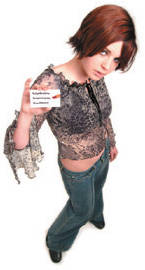Design a business card with style
You may have noticed some Business Cards look great whilst other Business Cards look amateurish. Some Business Cards give the impression of an established business whilst others look like fly-by-nighters. What is it that makes some Business Cards look more professional than others. Is it the colours of the Business Card? Is it the typeface used on the Business Card? Is it the layout of the Business Card?
 Great designs are not a mystery. By following some simple rules, you can
design your Business Cards with style. The secrets of great Business Card
design are easy to learn.
Great designs are not a mystery. By following some simple rules, you can
design your Business Cards with style. The secrets of great Business Card
design are easy to learn.
There are four areas that you can learn to ensure your Business Cards look professional and convey the image you want for your business. Lets look at these four areas that you can use as tools to evaluate your Business Cards design. Contrast - Repetition - Alignment - Proximity.
Contrast
The first thing to keep in mind when designing your Business Card is contrast. Contrast is a very important visual element on a Business Card. The simplest contrast is black text on white card. You can be very creative by using colours that have contrasting relationships such as blue and orange or red and green. Remember the colour wheel you learnt at school? To find a contrasting colour use opposite colours from the colour wheel. Typeface can be contrasted as well. You may use a strong bold typeface for your company name contrasted with a lighter type for the rest of the text on your Business Card.
Repetition
The next thing to look for is repeating elements throughout your Business Card. You can repeat colours, shapes, typefaces, textures, sizes, images on your Business Cards. How many typefaces have you used? Have you kept the sizes similar throughout the card? How many colours are used over the card? Do all the text and images have a consistent look and feel to them?
Beginner designers often fall into the trap of using lots of different typefaces on their Business Cards with lots of different sizes. By limiting your Business Card to one typeface family you will see a professional difference. Keep the size of the type on your Business Card consistent throughout. You can effectively repeat a single image on your card rather than clutter it up with multiple images.
Alignment
The next thing to look for is how text and images are aligned on your Business Card.
Our eyes find aligned text and objects pleasing. This is a very common mistake when designing Business Cards. Text on your Business Card may be aligned left or right or centred. As long as it is consistent over your Business Card. If you are using an image, find an element within it to align your text with on your Business Card. If you use rules (lines), they should begin and end in alignment with something else, like the text edge or text bottom. If your image hangs outside the alignment, crop it.
Proximity
The last thing that ensures great Business Card design is proximity. How close is information related to each other? Items related to each other should be grouped close together. For example you don't want your name to be a long way from your title as these are related information. Your contact details should be grouped together on your Business Card. Is your company name positioned prominently on your Business Card? Keep text at least 3mm from the edge of the card to avoid text looking like it is falling off the edge of your Business Card.
Style your Business Cards to match your business profile
By applying what you have just learnt to your Business Cards design, you will see an immediate improvement and be assured of professional looking Business Cards that reflect your business. Browse through the designs at Click Business Cards and you will see these principles in place.
To receive a free sample pack click here.